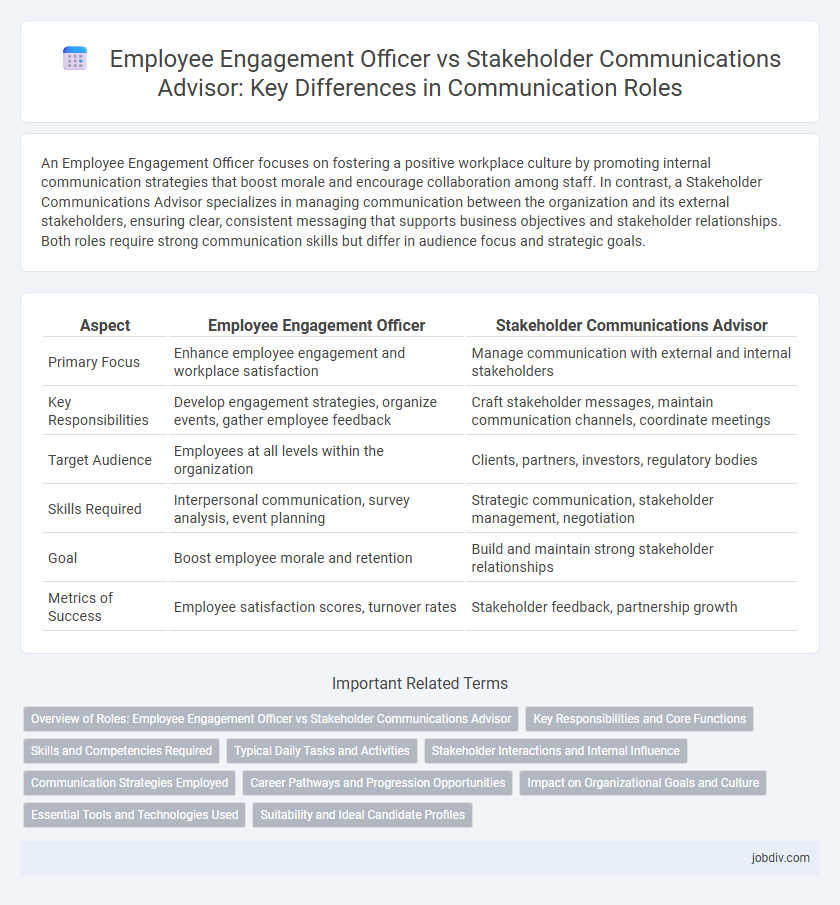An Employee Engagement Officer focuses on fostering a positive workplace culture by promoting internal communication strategies that boost morale and encourage collaboration among staff. In contrast, a Stakeholder Communications Advisor specializes in managing communication between the organization and its external stakeholders, ensuring clear, consistent messaging that supports business objectives and stakeholder relationships. Both roles require strong communication skills but differ in audience focus and strategic goals.
Table of Comparison
| Aspect | Employee Engagement Officer | Stakeholder Communications Advisor |
|---|---|---|
| Primary Focus | Enhance employee engagement and workplace satisfaction | Manage communication with external and internal stakeholders |
| Key Responsibilities | Develop engagement strategies, organize events, gather employee feedback | Craft stakeholder messages, maintain communication channels, coordinate meetings |
| Target Audience | Employees at all levels within the organization | Clients, partners, investors, regulatory bodies |
| Skills Required | Interpersonal communication, survey analysis, event planning | Strategic communication, stakeholder management, negotiation |
| Goal | Boost employee morale and retention | Build and maintain strong stakeholder relationships |
| Metrics of Success | Employee satisfaction scores, turnover rates | Stakeholder feedback, partnership growth |
Overview of Roles: Employee Engagement Officer vs Stakeholder Communications Advisor
Employee Engagement Officers focus on fostering internal communication strategies that enhance employee morale, participation, and alignment with organizational goals. Stakeholder Communications Advisors manage external and internal communications to ensure clear, consistent messaging tailored to diverse stakeholder groups, including investors, clients, and community partners. Both roles are pivotal in maintaining effective communication flows but differ in their audience focus and strategic priorities.
Key Responsibilities and Core Functions
An Employee Engagement Officer focuses on fostering internal communication, enhancing employee morale, and coordinating initiatives that drive workplace satisfaction and productivity. A Stakeholder Communications Advisor manages external and internal communications strategies, ensuring clear, consistent messaging to diverse audiences including investors, partners, and regulatory bodies. Both roles require strong communication skills, but the Employee Engagement Officer centers on internal culture, while the Stakeholder Communications Advisor prioritizes relationship management and strategic information dissemination.
Skills and Competencies Required
An Employee Engagement Officer requires strong interpersonal skills, emotional intelligence, and proficiency in creating motivational strategies to foster workplace culture and enhance team morale. A Stakeholder Communications Advisor needs expertise in strategic communication, project management, and stakeholder analysis to effectively manage relationships and deliver targeted messaging. Both roles demand exceptional writing skills, adaptability, and the ability to navigate complex organizational environments.
Typical Daily Tasks and Activities
Employee Engagement Officers focus on fostering a positive workplace culture by organizing staff surveys, managing internal communications, and coordinating team-building activities to boost morale and productivity. Stakeholder Communications Advisors specialize in crafting targeted messages, managing external and internal stakeholder relationships, and monitoring communication channels to ensure consistent brand messaging. Both roles require strong interpersonal skills, but Employee Engagement Officers prioritize internal employee experience, while Stakeholder Communications Advisors emphasize strategic communication with varied audiences.
Stakeholder Interactions and Internal Influence
An Employee Engagement Officer primarily focuses on fostering positive relationships and open communication channels within the organization to boost employee morale and productivity. In contrast, a Stakeholder Communications Advisor specializes in managing interactions with external and internal stakeholders, shaping messages to align with organizational goals and influence decision-making processes. Both roles require strategic communication skills, but the Employee Engagement Officer emphasizes internal engagement, while the Stakeholder Communications Advisor prioritizes stakeholder relationship management and internal influence.
Communication Strategies Employed
Employee Engagement Officers deploy internal communication strategies emphasizing transparency, feedback loops, and motivational content to boost workforce participation and morale. Stakeholder Communications Advisors utilize targeted messaging, reputation management, and relationship-building tactics tailored to external audiences, aligning corporate goals with stakeholder interests. Both roles leverage digital platforms and data analytics to optimize message reach and effectiveness across communication channels.
Career Pathways and Progression Opportunities
Employee Engagement Officers typically advance by deepening expertise in organizational behavior and internal communications, progressing to roles such as Internal Communications Manager or Director of Employee Experience. Stakeholder Communications Advisors often develop their career through expanding external relations skills, moving towards Senior Stakeholder Manager or Corporate Communications Director positions. Both pathways offer opportunities for specialization in digital communication platforms and strategic communication planning, enhancing influence within enterprise communication hierarchies.
Impact on Organizational Goals and Culture
An Employee Engagement Officer directly influences organizational goals by fostering a motivated and committed workforce, which enhances productivity and reduces turnover rates. In contrast, a Stakeholder Communications Advisor shapes culture and supports strategic objectives by managing clear, consistent messaging between the organization and its external and internal stakeholders. Both roles are critical, but the Employee Engagement Officer primarily drives internal cohesion, while the Stakeholder Communications Advisor ensures alignment and trust across broader stakeholder groups.
Essential Tools and Technologies Used
Employee Engagement Officers rely heavily on internal communication platforms such as intranet systems, employee survey tools like Qualtrics, and collaboration software including Microsoft Teams and Slack to foster workforce participation and monitor engagement levels. Stakeholder Communications Advisors utilize Customer Relationship Management (CRM) systems like Salesforce, media monitoring tools such as Meltwater, and project management applications like Asana to manage external communications and stakeholder relationships effectively. Both roles leverage data analytics and communication automation tools to enhance message targeting and measure communication impact.
Suitability and Ideal Candidate Profiles
An Employee Engagement Officer is best suited for roles that require fostering internal communication, boosting employee morale, and driving participation in company initiatives, ideally possessing strong interpersonal skills and experience in human resources or organizational development. In contrast, a Stakeholder Communications Advisor excels in managing external and internal communications with diverse groups, requiring expertise in strategic messaging, public relations, and stakeholder management. The ideal candidate for an Employee Engagement Officer typically demonstrates empathy and a deep understanding of workplace culture, while the Stakeholder Communications Advisor must showcase strategic thinking and proficiency in tailoring communications to varied stakeholders.
Employee Engagement Officer vs Stakeholder Communications Advisor Infographic

 jobdiv.com
jobdiv.com